Contents
Karbofos for strawberries is in demand among both gardeners and plantation owners. The effectiveness of the drug depends on the concentration of the solution and the correctness of its application.
Characteristics and action of the preparation
Karbofos is an acaricidal and insecticidal agent, assigned to the class of organophosphorus compounds. The drug has a wide spectrum of action: it is also used in agriculture, it helps in the fight against various pests. In medicine, Karbofos is known as a means for sanitary and household disinfection.
The active substance of the drug is a component of malathion. It is a colorless liquid with an unpleasant thiol-like odor. To the touch, undiluted Karbaphos has an oily texture. Diethyldithiophosphoric acid is present as an impurity.
Malathion slowly hydrolyzes in water, has thermal stability, but when mixed with acid, it transforms into a more active form – this is malaoxone.
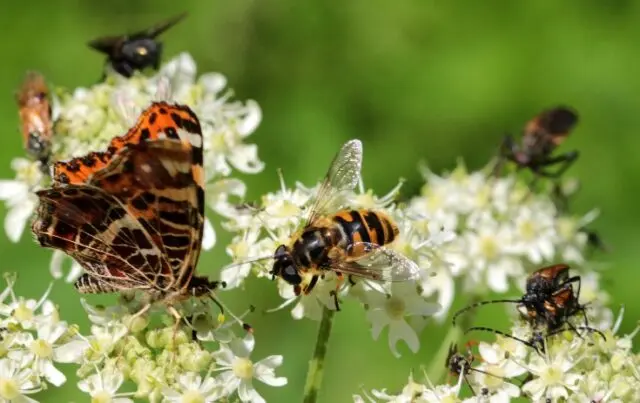
The first developments of Karbofos belong to academician Arbuzov, who received a prototype of a modern drug in the 20th century
The insecticide has the principle of intestinal-contact action. When it enters the digestive system of an insect, Karbofos poisons it. Complete death of the pest occurs in 3-4 hours.
If you process strawberries with Karbofos in autumn, spring and summer several times, then its effectiveness is significantly reduced. This is due to the fact that insects, in response to poison, produce an enzyme that neutralizes harmful substances. It is recommended to treat 2-3 times a year.
Advantages and disadvantages
There is a significant variety of insecticides on the market, however, Karbofos has a number of advantages:
- efficiency (destroys most pests after primary processing);
- remains valid for two months;
- able to kill bedbugs at any stage of development;
- affects ants, cockroaches, fleas;
- present in stores of various dosage forms (emulsion and powder).
The only significant drawback when treating strawberries from pests with Karbofos is the presence of a strong toxic odor that can persist for several months. Under the influence of environmental factors, the insecticide quickly disintegrates: on the street after ten days, in the greenhouse – after a week.
Application area
The drug is widely used in agricultural production, in the forestry industry for disinfecting work. The chemical is also popular with warehouse owners who want to keep their inventory free of pests.
In the agricultural industry, the insecticide effectively destroys aphids, spider mites, suckers, bedbugs, whiteflies and ants.
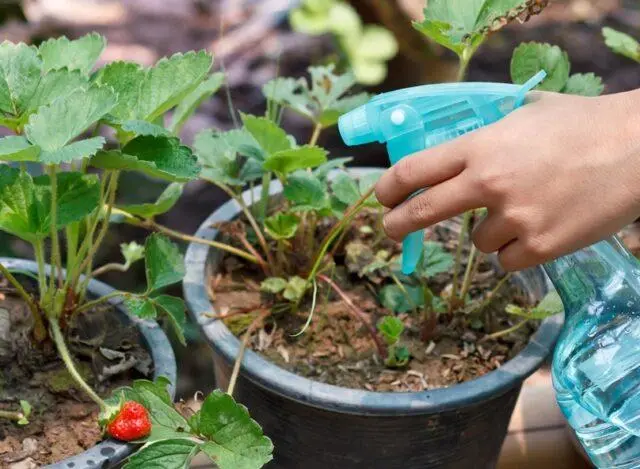
Karbofos fights not only pests, but also pollinating insects
Is it possible to process strawberries with Karbofos
This crop needs protection throughout the growing season. Karbofos can be sprayed with strawberries in autumn and spring. For maximum effect, follow the instructions for use.
How to properly process strawberries with Karbofos
All work must be scheduled in advance. Prepare equipment, utensils, tools. Weather conditions, the amount of cultivated area, the time of year should be taken into account.
The optimum air temperature for processing strawberries is 12-25 °C. With an increase or decrease in these values, the effectiveness of the drug noticeably changes for the worse.
To prepare the solution, it is best to use water with neutral acidity or slightly acidic. If the pH is above 7, then Karbofos may partially lose its properties. To acidify the water, you can use citric acid. To do this, it is enough to dissolve 10-3 g of the substance in 5 liters of water. If acetic acid is available, then add 5 ml of 9% essence to 10 liters of water.
The optimum liquid temperature is 10-16 °C. Often gardeners prefer water from open reservoirs or wells. In this case, it must be dialed in advance and allowed to stand and warm up. In cold water, Karbofos dissolves worse. If the liquid is preheated, it will lose some of the oxygen.
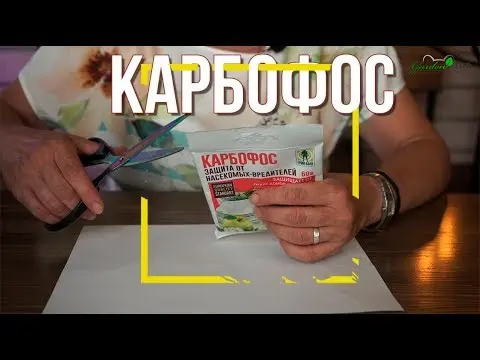
When preparing a solution of Karbofos, it is forbidden to use food utensils: it is better to give preference to special containers
Rules for working with insecticide when spraying strawberries:
- The procedure must be carried out either before the appearance of pests, or at the height of their activity, but before the start of reproduction.
- Strawberry beds should be prepared: weed, remove plants pollinated by bees. Dry shoots and leaves are recommended to be removed. If there are hives on the site, then cover them with a film.
- Process not only the upper part of the bush, but also the leaves from the underside. A solution of Karbofos should get on all parts of the plant.
- Spraying strawberries is required evenly using a spray bottle or other dispenser. It is necessary to ensure that the substance does not flow down to the ground. To spray strawberries evenly, it is recommended to keep the tip of the sprayer at a distance of no more than 50 cm from the bush.
- The optimal time for work is the evening, when the activity of most insects is significantly reduced, and the drug, due to temperature differences, will stay longer on the leaves in the form of drops.
- Do not process strawberries during rain or heavy wind. If bad weather breaks out after the procedure, then irrigation should be repeated under more favorable conditions.
- The prepared solution cannot be stored, it must be used immediately. The duration of work should not exceed an hour. Dispose of the remaining solution.
Processing strawberries with Karbofos in spring
After the snow melts, all nature awakens, including ticks and strawberry weevils. Their appearance coincides with the laying of buds in strawberries. Therefore, in the spring, it is necessary to breed Karbofos for processing before flowers appear. Treated bushes should be covered with a film for 10-12 hours.
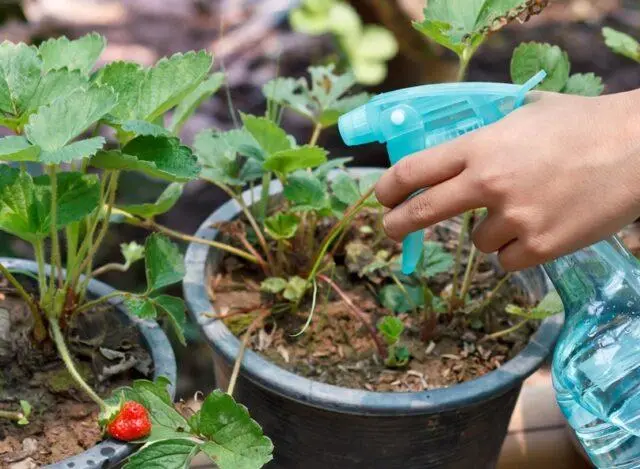
The best spray tool is a spray bottle.
Processing strawberries with Karbofos in autumn
At the end of summer, the plant must be protected from ticks. After harvesting, strawberries can be processed with Karbofos. To do this, dissolve 8 g of powder in 60 liters of water and irrigate the plants with the prepared remedy. After the procedure, it is recommended to cover the bed with strawberries with a film and leave for 10-12 hours.
Is it possible to use Karbofos with other means
According to the instructions, you can not combine the insecticide with other drugs of similar purpose. It is recommended to use analogues no earlier than ten days after spraying strawberries with an insecticide.
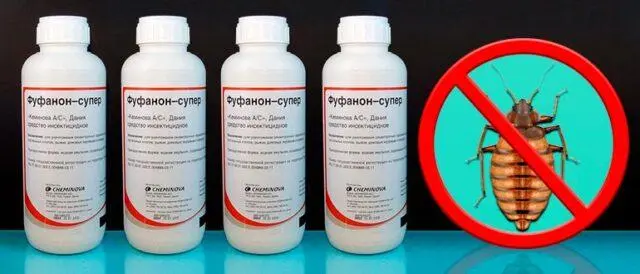
Actions and properties similar to Karbofos are possessed by such agents as Fufanon or Kinmiks
Safety Precautions
Before diluting Karbofos for spraying strawberries, it must be borne in mind that the third hazard class has been exposed to the drug. This means that it poses a minor threat to humans, birds and animals, but is toxic to insects.
Safety precautions:
- All work must be carried out using protective equipment. Rubberized gloves, goggles, pants and long sleeve shirt in canvas. All equipment must be put on before preparing the solution and removed only after irrigating the strawberries.
- During operation, you need to use a sprayer or spray gun.
- You can not eat food, drink water.
- It is forbidden to irrigate strawberries with Karbofos if the distance from the beds to the hives is less than 5 km.
- It should be borne in mind that at elevated air temperatures the substance decomposes faster.
- After processing strawberries, be sure to change clothes. All equipment should be washed with detergent.
- At the end of the work, clean the nasal cavity, rinse your face with water, wash your hands with soap and water.
- Opened preparation should be stored in places where moisture does not penetrate. Do not place the box near food, a source of fire, liquids for drinking.
- Be sure to limit the contact of Karbofos with small children and animals.
When using the sprayer, it is impossible to raise the tip high, check its performance by bringing it close to the face.
Conclusion
Karbofos for strawberries should be applied as an insecticide twice a year. Be sure to follow the instructions, use protective equipment. You can irrigate strawberries with a spray gun or a sprayer away from beehives, reservoirs. To achieve the maximum effect, it should be sunny warm weather.









